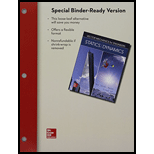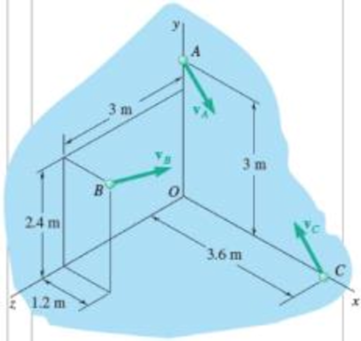
VECTOR MECH...,STAT.+DYNA.(LL)-W/ACCESS
11th Edition
ISBN: 9781259633133
Author: BEER
Publisher: MCG
expand_more
expand_more
format_list_bulleted
Concept explainers
Textbook Question
Chapter 14.1, Problem 14.13P
A system consists of three particles A, B, and C. We know that mA = 3 kg, mB = 2 kg, and mC = 4 kg and that the velocities of the particles expressed in m/s are, respectively, vA = 4i + 2j + 2k, vB = 4i + 3j, and vC = −2i + 4j + 2k. Determine the angular momentum HO of the system about O.
Fig. P14.13

Expert Solution & Answer
Want to see the full answer?
Check out a sample textbook solution
Students have asked these similar questions
given below:
A rectangular wing with wing twist yields the spanwise circulation distribution
kbV1
roy) = kbv. (2)
where k is a constant, b is the span length and V. is the free-stream velocity. The wing has an
aspect ratio of 4. For all wing sections, the lift curve slope (ag) is 2 and the zero-lift angle of
attack (a=0) is 0.
a. Derive expressions for the downwash (w) and induced angle of attack a distributions
along the span.
b. Derive an expression for the induced drag coefficient.
c. Calculate the span efficiency factor.
d. Calculate the value of k if the wing has a washout and the difference between the
geometric angles of attack of the root (y = 0) and the tip (y = tb/2) is:
a(y = 0) a(y = ±b/2) = /18
Hint: Use the coordinate transformation y = cos (0)
۳/۱
العنوان
O
не
شكا
+91x PU + 96852
A heavy car plunges into a lake during an accident and lands at the bottom of the lake
on its wheels as shown in figure. The door is 1.2 m high and I m wide, and the top edge of
Deine the hadrostatic force on the
Plot the displacement diagram for a cam with roller follower of diameter 10 mm. The required
motion is as follows;
1- Rising 60 mm in 135° with uniform acceleration and retardation motion.
2- Dwell 90°
3- Falling 60 mm for 135° with Uniform acceleration-retardation motion.
Then design the cam profile to give the above displacement diagram if the minimum circle
diameter of the cam is 50 mm.
=
-20125
750 x2.01
Plot the displacement diagram for a cam with roller follower of diameter 10 mm. The required
motion is as follows;
1- Rising 60 mm in 135° with uniform acceleration and retardation motion.
2- Dwell 90°
3- Falling 60 mm for 135° with Uniform acceleration-retardation motion.
Then design the cam profile to give the above displacement diagram if the minimum circle
diameter of the cam is 50 mm.
Chapter 14 Solutions
VECTOR MECH...,STAT.+DYNA.(LL)-W/ACCESS
Ch. 14.1 - A 30-g bullet is fired with a horizontal velocity...Ch. 14.1 - Two identical 1350-kg automobiles A and B are at...Ch. 14.1 - Prob. 14.3PCh. 14.1 - Prob. 14.4PCh. 14.1 - Two swimmers A and B, of weight 190 lb and 125 lb,...Ch. 14.1 - A 180-lb man and a 120-lb woman stand side by side...Ch. 14.1 - A 40-Mg boxcar A is moving in a railroad...Ch. 14.1 - Two identical cars A and B are at rest on a...Ch. 14.1 - A 20-kg base satellite deploys three...Ch. 14.1 - For the satellite system of Prob. 14.9, assuming...
Ch. 14.1 - A system consists of three identical 19.32-lb...Ch. 14.1 - A system consists of three identical 19.32-lb...Ch. 14.1 - A system consists of three particles A, B, and C....Ch. 14.1 - For the system of particles of Prob. 14.13,...Ch. 14.1 - A 13-kg projectile is passing through the origin O...Ch. 14.1 - Prob. 14.16PCh. 14.1 - A 2-kg model rocket is launched vertically and...Ch. 14.1 - An 18-kg cannonball and a 12-kg cannonball are...Ch. 14.1 - Prob. 14.19PCh. 14.1 - Prob. 14.20PCh. 14.1 - Prob. 14.21PCh. 14.1 - Two spheres, each of mass m, can slide freely on a...Ch. 14.1 - Prob. 14.23PCh. 14.1 - Prob. 14.24PCh. 14.1 - Prob. 14.25PCh. 14.1 - In a scattering experiment, an alpha particle A is...Ch. 14.1 - Derive the relation HO=rmv+HG between the angular...Ch. 14.1 - Prob. 14.28PCh. 14.1 - Prob. 14.29PCh. 14.1 - Show that the relation MA=HA, where HA is defined...Ch. 14.2 - Determine the energy lost due to friction and the...Ch. 14.2 - Prob. 14.32PCh. 14.2 - Prob. 14.33PCh. 14.2 - Determine the energy lost as a result of the...Ch. 14.2 - Prob. 14.35PCh. 14.2 - Prob. 14.36PCh. 14.2 - Prob. 14.37PCh. 14.2 - 14.38 Two hemispheres arc held together by a cord...Ch. 14.2 - A 15-lb block B starts from rest and slides on the...Ch. 14.2 - A 40-lb block B is suspended from a 6-ft cord...Ch. 14.2 - Prob. 14.41PCh. 14.2 - 14.41 and 14.42 In a game of pool, ball A is...Ch. 14.2 - Prob. 14.43PCh. 14.2 - In a game of pool, ball A is moving with the...Ch. 14.2 - Prob. 14.45PCh. 14.2 - Prob. 14.46PCh. 14.2 - Four small disks A, B, C, and D can slide freely...Ch. 14.2 - In the scattering experiment of Prob. 14.26, it is...Ch. 14.2 - Prob. 14.49PCh. 14.2 - Three small spheres A, B, and C, each of mass m,...Ch. 14.2 - Prob. 14.51PCh. 14.2 - Prob. 14.52PCh. 14.2 - Two small disks A and B of mass 3 kg and 1.5 kg,...Ch. 14.2 - Two small disks A and B of mass 2 kg and 1 kg,...Ch. 14.2 - Prob. 14.55PCh. 14.2 - Prob. 14.56PCh. 14.3 - A stream of water with a density of = 1000 kg/m3...Ch. 14.3 - A jet ski is placed in a channel and is tethered...Ch. 14.3 - Prob. 14.59PCh. 14.3 - Prob. 14.60PCh. 14.3 - Prob. 14.61PCh. 14.3 - Prob. 14.62PCh. 14.3 - Prob. 14.63PCh. 14.3 - Prob. 14.64PCh. 14.3 - Prob. 14.65PCh. 14.3 - Prob. 14.66PCh. 14.3 - Prob. 14.67PCh. 14.3 - Prob. 14.68PCh. 14.3 - Prob. 14.69PCh. 14.3 - Prob. 14.70PCh. 14.3 - Prob. 14.71PCh. 14.3 - Prob. 14.72PCh. 14.3 - Prob. 14.73PCh. 14.3 - Prob. 14.74PCh. 14.3 - Prob. 14.75PCh. 14.3 - Prob. 14.76PCh. 14.3 - The propeller of a small airplane has a...Ch. 14.3 - Prob. 14.78PCh. 14.3 - Prob. 14.79PCh. 14.3 - Prob. 14.80PCh. 14.3 - Prob. 14.81PCh. 14.3 - Prob. 14.82PCh. 14.3 - Prob. 14.83PCh. 14.3 - Prob. 14.84PCh. 14.3 - Prob. 14.85PCh. 14.3 - Prob. 14.86PCh. 14.3 - Solve Prob. 14.86, assuming that the chain is...Ch. 14.3 - Prob. 14.88PCh. 14.3 - Prob. 14.89PCh. 14.3 - Prob. 14.90PCh. 14.3 - Prob. 14.91PCh. 14.3 - Prob. 14.92PCh. 14.3 - A rocket sled burns fuel at the constant rate of...Ch. 14.3 - Prob. 14.94PCh. 14.3 - Prob. 14.95PCh. 14.3 - Prob. 14.96PCh. 14.3 - Prob. 14.97PCh. 14.3 - Prob. 14.98PCh. 14.3 - Determine the distance traveled by the spacecraft...Ch. 14.3 - A rocket weighs 2600 lb, including 2200 lb of...Ch. 14.3 - Determine the altitude reached by the spacecraft...Ch. 14.3 - Prob. 14.102PCh. 14.3 - Prob. 14.103PCh. 14.3 - Prob. 14.104PCh. 14 - Three identical cars are being unloaded from an...Ch. 14 - Prob. 14.106RPCh. 14 - An 80-Mg railroad engine A coasting at 6.5 km/h...Ch. 14 - Prob. 14.108RPCh. 14 - Mass C, which has a mass of 4 kg, is suspended...Ch. 14 - Prob. 14.110RPCh. 14 - Prob. 14.111RPCh. 14 - Prob. 14.112RPCh. 14 - Prob. 14.113RPCh. 14 - Prob. 14.114RPCh. 14 - Prob. 14.115RPCh. 14 - A chain of length l and mass m falls through a...
Knowledge Booster
Learn more about
Need a deep-dive on the concept behind this application? Look no further. Learn more about this topic, mechanical-engineering and related others by exploring similar questions and additional content below.Similar questions
- Q1/ A vertical, circular gate with water on one side as shown. Determine the total resultant force acting on the gate and the location of the center of pressure, use water specific weight 9.81 kN/m³ 1 m 4 marrow_forwardI need handwritten solution with sketches for eacharrow_forwardGiven answers to be: i) 14.65 kN; 6.16 kN; 8.46 kN ii) 8.63 kN; 9.88 kN iii) Bearing 6315 for B1 & B2, or Bearing 6215 for B1arrow_forward
- (b) A steel 'hot rolled structural hollow section' column of length 5.75 m, has the cross-section shown in Figure Q.5(b) and supports a load of 750 kN. During service, it is subjected to axial compression loading where one end of the column is effectively restrained in position and direction (fixed) and the other is effectively held in position but not in direction (pinned). i) Given that the steel has a design strength of 275 MN/m², determine the load factor for the structural member based upon the BS5950 design approach using Datasheet Q.5(b). [11] ii) Determine the axial load that can be supported by the column using the Rankine-Gordon formula, given that the yield strength of the material is 280 MN/m² and the constant *a* is 1/30000. [6] 300 600 2-300 mm wide x 5 mm thick plates. Figure Q.5(b) L=5.75m Pinned Fixedarrow_forwardHelp ارجو مساعدتي في حل هذا السؤالarrow_forwardHelp ارجو مساعدتي في حل هذا السؤالarrow_forward
- Q2: For the following figure, find the reactions of the system. The specific weight of the plate is 500 lb/ft³arrow_forwardQ1: For the following force system, find the moments with respect to axes x, y, and zarrow_forwardQ10) Body A weighs 600 lb contact with smooth surfaces at D and E. Determine the tension in the cord and the forces acting on C on member BD, also calculate the reaction at B and F. Cable 6' 3' wwwarrow_forward
- Help ارجو مساعدتي في حل هذا السؤالarrow_forwardQ3: Find the resultant of the force system.arrow_forwardQuestion 1 A three-blade propeller of a diameter of 2 m has an activity factor AF of 200 and its ratio of static thrust coefficient to static torque coefficient is 10. The propeller's integrated lift coefficient is 0.3.arrow_forward
arrow_back_ios
SEE MORE QUESTIONS
arrow_forward_ios
Recommended textbooks for you
 Elements Of ElectromagneticsMechanical EngineeringISBN:9780190698614Author:Sadiku, Matthew N. O.Publisher:Oxford University Press
Elements Of ElectromagneticsMechanical EngineeringISBN:9780190698614Author:Sadiku, Matthew N. O.Publisher:Oxford University Press Mechanics of Materials (10th Edition)Mechanical EngineeringISBN:9780134319650Author:Russell C. HibbelerPublisher:PEARSON
Mechanics of Materials (10th Edition)Mechanical EngineeringISBN:9780134319650Author:Russell C. HibbelerPublisher:PEARSON Thermodynamics: An Engineering ApproachMechanical EngineeringISBN:9781259822674Author:Yunus A. Cengel Dr., Michael A. BolesPublisher:McGraw-Hill Education
Thermodynamics: An Engineering ApproachMechanical EngineeringISBN:9781259822674Author:Yunus A. Cengel Dr., Michael A. BolesPublisher:McGraw-Hill Education Control Systems EngineeringMechanical EngineeringISBN:9781118170519Author:Norman S. NisePublisher:WILEY
Control Systems EngineeringMechanical EngineeringISBN:9781118170519Author:Norman S. NisePublisher:WILEY Mechanics of Materials (MindTap Course List)Mechanical EngineeringISBN:9781337093347Author:Barry J. Goodno, James M. GerePublisher:Cengage Learning
Mechanics of Materials (MindTap Course List)Mechanical EngineeringISBN:9781337093347Author:Barry J. Goodno, James M. GerePublisher:Cengage Learning Engineering Mechanics: StaticsMechanical EngineeringISBN:9781118807330Author:James L. Meriam, L. G. Kraige, J. N. BoltonPublisher:WILEY
Engineering Mechanics: StaticsMechanical EngineeringISBN:9781118807330Author:James L. Meriam, L. G. Kraige, J. N. BoltonPublisher:WILEY

Elements Of Electromagnetics
Mechanical Engineering
ISBN:9780190698614
Author:Sadiku, Matthew N. O.
Publisher:Oxford University Press

Mechanics of Materials (10th Edition)
Mechanical Engineering
ISBN:9780134319650
Author:Russell C. Hibbeler
Publisher:PEARSON

Thermodynamics: An Engineering Approach
Mechanical Engineering
ISBN:9781259822674
Author:Yunus A. Cengel Dr., Michael A. Boles
Publisher:McGraw-Hill Education

Control Systems Engineering
Mechanical Engineering
ISBN:9781118170519
Author:Norman S. Nise
Publisher:WILEY

Mechanics of Materials (MindTap Course List)
Mechanical Engineering
ISBN:9781337093347
Author:Barry J. Goodno, James M. Gere
Publisher:Cengage Learning

Engineering Mechanics: Statics
Mechanical Engineering
ISBN:9781118807330
Author:James L. Meriam, L. G. Kraige, J. N. Bolton
Publisher:WILEY
Dynamics - Lesson 1: Introduction and Constant Acceleration Equations; Author: Jeff Hanson;https://www.youtube.com/watch?v=7aMiZ3b0Ieg;License: Standard YouTube License, CC-BY